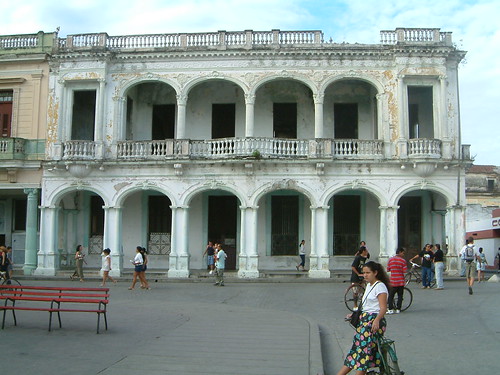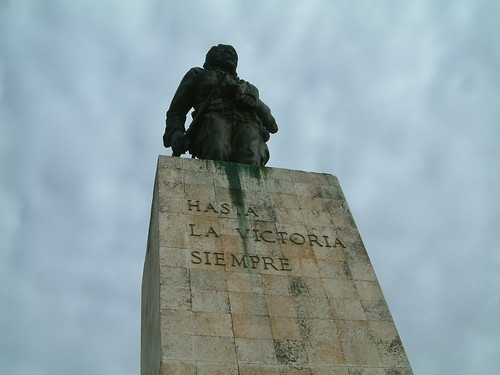We step out of our casa particular in Vedado, a suburb of Havana, and immediately see what will become the familiar silhouette of Ernesto Che Gueverra. As expected, there are frequent reminders of Cuba’s history wherever you turn–inspirational quotes from Cuba’s national hero, José MartÃ, and dates of historical importance that most, if not all, Cubans know by heart: July 26, El Triunfo de la Revolución, the Triumph of the Revolution; October 10, the War of Independence; January 1, Liberation Day.
We arrived last night from a direct four-hour flight from Montréal. We showed our passports to the customs agent, answered a few questions and made sure that only our tourists cards were stamped. Baggage claim was an agonizingly slow process. But once we exited the terminal we were welcomed by Joél and his father, Paolo. For US$25 they drive us to Señora Aleida’s house in Vedado where we will be staying for the next three nights.

Tourism flourishes in Cuba despite the embargo imposed by the United States in the 1950s. Luxury hotels cater to well-heeled Canadians and Europeans willing to pay up to US$500 a night for a room. Our travel ethic has always been to get closer to the local people and their culture, so we opted to stay in casas particulares, private homes with rooms for rent, throughout our travels in the country. Señora Aleida and I have been communicating via e-mail for three months prior to our arrival, finalizing our itinerary and booking other casas to stay in once outside of Havana. I told her we wanted to go to a beach. She arranged for us to visit four.

Havana looks exactly how we’ve seen it in magazines and in photographs: it’s a museum in itself. Old Cadillacs and Pontiacs cruise the roads. Pre-revolutionary mansions have a faded grandeur suggestive of more materially prosperous times. They are now badly in need of paint jobs and general upkeep. Almost everything is touched with a bit of disrepair. But some things, like the old model cars whose engines have been replaced, are ingeniously and almost lovingly maintained. The newer cars we see on the street are from Europe and Korea. There are no fast food chains except for one that’s appropriately named El Rapido and Ditú, a chicken joint.

Cubans apparently do not hang out in coffee shops. But we see people waiting by their stoops, their balconies or by their windows. There are lines for pizza folded like tacos, lines to buy helado or ice cream, lines to enter stores and lines to either board a bus or catch a ride with a taxi particular. There is a lot of waiting in Cuba, and we imagine, expectation as well.
Our first full day in Havana and Vicente, who lives downstairs, is waiting outside to drive us around for US$20. We’ve followed the advice of others who have come before us and have brought the basics with us–things like soap. Señora Aleida prepares our first breakfast consisting of one of the many tortas, omelettes, we’ll eat over the next couple of weeks. There is bread, butter, fruit and most notably the thick, black Cuban coffee that could probably fuel cars as well as fuel our mornings. She sits with us after we eat to finalize our itinerary. She provides us with detailed instructions on when and where to make our connections, all in Spanish. I understand most of what I hear, but not good enough to answer in complete grammatically-correct sentences. The boy is better in Spanish and so becomes the designated speaker for the rest of the trip.
Vicente drives through the Malecón, a highway along the coast of the Gulf of Mexico. Waves are furiously crashing against the seawall. We tighten our light jackets as the weather in Havana is surprisingly mild.
Our first stop is Cementerio Colón, the main cemetery of Havana that is full of funerary sculptures and stories. We did not know we could get a map with our US$1 admission. We walked around casually and somewhat aimlessly. One of the security guards approached us after seeing me flinch when I saw two dead chickens lying in one of the small alleys. Santeria, he says, referring to the Afro-Cuban religion brought by the hundreds of thousands of slaves in the mid-16th century. It’s part of Cuba’s cultural heritage, co-existing alongside Christianity and the Regla Conga, a faith brought by the congos, the slaves from Bantu-speaking regions of the Congo Basin. The chickens are sacrificed for the souls of the dead to rest.

He pointed out certain tombstones, ones with stories and immediate tourist appeal. A tombstone with a double-three domino tile on top: the person died of a heart attack while playing dominoes, moments after realizing that the the double-three in his hand was the winning tile. We also passed by the tomb of Amelia Goyri, known as La Milagrosa, who died during childbirth. Now, tourists and Havana residents alike, pray for their own safe childbirth by walking around the grave and knocking three times on the tomb, the same way his inconsolable widower knocked to wake her up. Near the tomb are several votive offerings from believers and miracle receivers from all over the world.
Each gravesite is bought by a family. Bones are eventually exhumed and transferred to a separate smaller container at the head of the tomb to make room for the next family member who dies. For the less fortunate, the other side of the cemetery has an area where stone containers with skeletal remains are unceremoniously stacked. Some are marked with a chalked X indicating that family’s inability to make payments on the gravesite within a three-month window. Those families who are unable to pay the costs of a gravesite are relegated to this area where remains are out in plain view. We thanked Ivan with a US$5 bill (like a strong Russian!, he said) for the stories that made the cemetery more engaging than it originally appeared.
For lunch, we ask Vicente to drive us to a paladar, licensed and taxed restaurants, where we can get our first taste of Cuban food in Cuba. He took us to Aries where we were let in by a waiter who asked us if we had reservations. We were directed to a separate room because we didn’t and were surprised when the door was closed behind us with Vicente standing outside. We would later learn that most Cubans are not allowed in the paladares that serve tourists. Even if they were, presumably the US$10 to $25 main course prices would not sit well. We ordered our first arroz con pollo. It came with a side of shredded cabbage and tomato, a salad that will be a fixture of our meals in Cuba.
Our next stop is Plaza de la Revolución, the site of the largest Che display in Havana. Hasta la victoria siempre is one of the many revolutionary slogans we will see posted around the country. The plaza is disappointingly empty. However, we were told Cubans congregated here during the Revolution and still do so for commemorative events. The rather phallic memorial dedicated to José Martá is across the street. There is a lift to access the highest point in Havana, but because it is Sunday, uniformed guards stop us from ascending the ramp and entering the premises.

Havana’s Chinatown, El Barrio Chino, is notable for the complete absence of anyone who looks remotely like us. We get a fair share of inquisitive stares and guesses at our nationalities: Chino! Japon! Corea! Perhaps the irony of being the only Asians in the immediate area is not lost upon the people around us. We’re approached by waiters seeking to lure us into their restaurants for lunch. Strangers put their arms around us and tell us they know the best place to get cigars for cheap.
While Chinatown’s streets are littered and cramped, it’s immediately apparent that La Habana Vieja, Old Havana, is where most restoration efforts are concentrated. Naturally, this is where the tourists are, and there are small galleries, gift shops and cafes to service us. The Castillo del Morro, built to protect Spain’s fleets from pirate attack back in the 16th century, is on the harbor side. It is illuminated at night as is the Fortaleza de San Carlos de la Cabana, the fortress Che took possession of upon his triumphant arrival after the dictator Batista fled in 1959. Every night the cannon is fired to commemorate the closure of the city walls to protect Havana during the war.

We also go to the Capitolio which was built during the era of the dictator Machado. It is styled after the U.S. Capitol in Washington, D.C. Ask any Cuban and they will tell you that yes, it is inspired by the U.S. Capitol “but is higher and even more grand.” We rest and sit on what used to be the Senate’s steps. It is now the National Library of Science and Technology. I eat my US$1 ice cream while watching the many bicitaxis and cocotaxis, mopeds encased in yellow round domes, puttering by.
Before we head home, we pass by Miramar, the residential area where wealthy families lived before the Revolution and is now occupied by embassies and government offices. The buildings here are all gated. They’re absolutely beautiful and well kept. Security guards are all over place. Mercedes Benzs and Audis roll around here. We walked around trying to match flags with the countries. The Philippines and North Korea were two notable sightings.
We planned not to have dinner at Señora Aleida’s house that evening. While waiting to leave for the Jazz Café, we play a game of Scrabble with her son, Alejandro. He studied computer science in college and is now working as a programmer. The lights go off for a couple of hours, but we continue our game with charged fluorescent lamps while eating popcorn Señora made for us. When the lights return, Alejandro and his girlfriend join us to go to the Jazz Café where US$10 covers dinner and drinks. A live jazz band played some standards while we ate our paella and spaghetti. We drink mojitos and Cristal, Cuba’s national beer, while swapping stories about our respective cultures.
Related post/s:
Havana, Cuba photos on Flickr






















